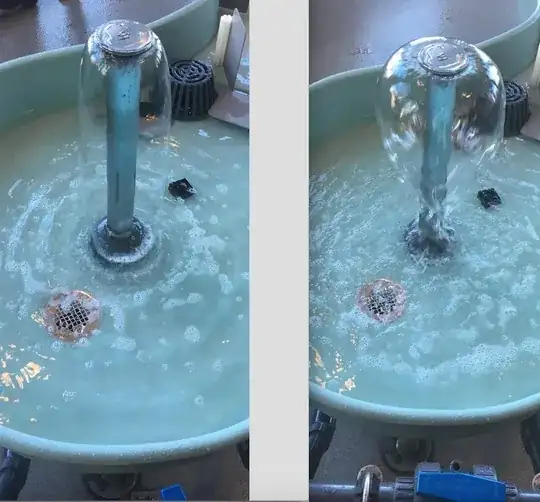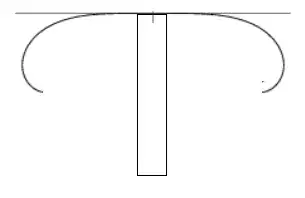In a children's museum, I ran across this fountain. You can adjust the flow rate with a valve, visible at the bottom. At low flow rates, the sheet of water does more or less what you'd expect: it curves downward, eventually falling more or less vertically. When you increase the flow rate, a surprising thing happens: the sheet of water curls back in toward the center. What causes this? Whatever it is, it seems that it must overcome the additional outward momentum of the water and then some. It is hard for me to believe that it is a result of surface tension for this reason--why should surface tension be so much stronger at the higher flow rate? Is it an aerodynamic effect? I did a brief internet search and didn't find anything. 
4 Answers
This is probably caused by a ring-shaped whirl of air (similar to a "smoke ring") under the water sheet which is driven by the speed of the water. This whirl flow produces a lower air pressure at the inner side of the falling water sheet that sucks it to the inside.
- 18,177
Yes, this effect comes from fluid dynamics. The material of effect is pressurized air which is circle-flowing under the water. At low velocity, the air is not having large impact. As velocity gets higher, air seeks to fill the low-pressurized region in lower segment of flow, creating more tight loop. This loop is sucking water to closure it, also protecting from mixing with outside air.
- 885
- 5
- 8
Shall attempt an explanation as I imagined it to be .. this is a naturally formed hydrofoil in hydrodynamical action.
At low discharges ( $ Q= A\, v$) that means low radial jet velocity the water bubble droops down like a bullet of low speed issuing from a gun barrel but falling down in the viscinity itself, first pic.
As the film falls there is an extra $ v_2= \sqrt {2 g h }$ velocity contributed due to acceleration of fall of gravity that adds up to a higher streamline speed $v$, as in second pic.
By (the corrosponding) Bernoulli's Law in hydrodynamics higher velocity means vacuum along a stream line ( like in an airfoil top surface.. here it is a water foil ) there is a small cavitation due to vacuum and the relatively higher pressure inside blows the film out. You can familiarly notice a plastic sheet spread on top of an accelerating SUV on the highway getting blown to a lower radius. The same pressure differential acts on the water film of reduced thickness.
If you sketch a toroid meridian of increasing curvature it has to curve in due to a sufficiently high streamline speed as shown in the exaggerated sketch of a Cornu spiral whose curvature is proportional to (square of) hydrofoil streamline length; higher the combined speed due to free fall, the higher the film curvature.
The inward pull is evident in the latter part of contour cross section.
Due to continued adhesive force/surface tension droplet separation takes place after continuing for a short radial distance.
- 1,142
